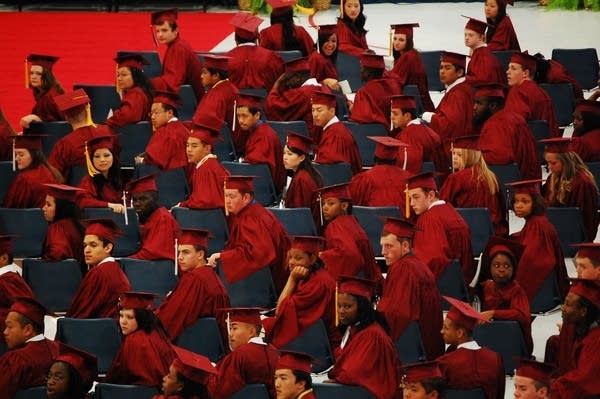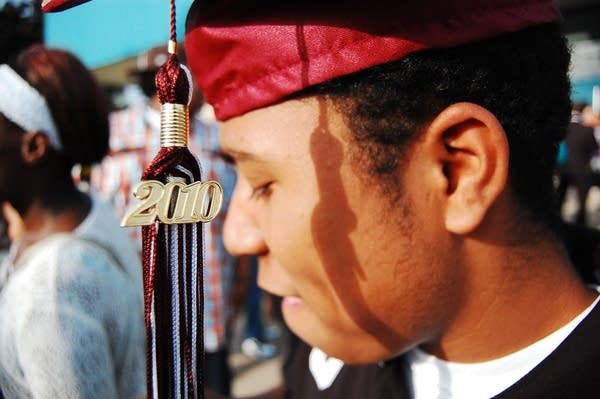College offers fresh challenges for grads in grant program
Go Deeper.
Create an account or log in to save stories.
Like this?
Thanks for liking this story! We have added it to a list of your favorite stories.

Nearly a decade ago, the Minneapolis Foundation promised a $10,000 college scholarship to more than 360 third graders in high-poverty schools in the Twin Cities through a program called Destination 2010.
All the students had to do was get their high school diploma from a school in the Minneapolis or St. Paul district.
It looks like 114 of the students in the class of 2010 will be eligible for the scholarship.
Those students may have made it past high school, but they face many more challenges as they enter college.
Turn Up Your Support
MPR News helps you turn down the noise and build shared understanding. Turn up your support for this public resource and keep trusted journalism accessible to all.
For seniors at St. Paul's Johnson High School, graduation is definitely not a quiet, solemn ceremony marking the transition from one part of life to another.
I want to see what college is like, but I'm nervous at the same time because it's just so much stuff that you gotta figure out.
At times it's even hard to hear the names of the graduates as they're drowned out by the shouts of enthusiastic parents and supportive friends.
Rakeem Amerson's name was somewhere amidst the shouting. He is one of 364 students who were part of Destination 2010.
A few weeks before his graduation, in the much quieter confines of the St. Paul apartment he shares with his grandmother, Amerson said the Destination 2010 scholarship definitely kept him focused on what he wanted to do after graduation.
"It's like a 50-50 chance I would have gone to college without the scholarship," he said. "But when you add the scholarship it's a 100 percent chance I'm going to go because why would you just throw away the money."
In reality, $10,000 for college isn't all that much these days. One year of tuition at the University of Minnesota costs around $11,000. Tuition at the state's private liberal arts colleges averages $30,000. That doesn't even take into consideration the cost of room and board.
So, for the Destination 2010 graduates, coming up with the rest of the cost of college is challenge No. 1.

And while the numbers are certainly daunting, it may not be the toughest hurdle for this group.
Students from low-income families are often able to use a mix of need-based federal and state grants plus scholarships to cover much of their tuition bill. The Minneapolis Foundation helped Destination 2010 families navigate the often confusing world of financial aid.
Those who do fill the financing gap need to be ready for the academic and cultural shocks that await on campuses often far from home.
The Minneapolis Foundation worked with students over the last decade to keep college in their sights. They took students on campus visits so they could imagine themselves there, and they made sure students were taking the right classes in high school.
Amerson says he's been given more advice in recent weeks. The message seems to be: You've graduated. That's great! Now things are going to get tough.
"Expect the ups and downs, expect the struggles," he said. "Expect to be going through some stuff. Expect it to be kind of hard. It's not just going to be easy. You've got to prepare yourself for that."
Destination 2010 program manager Kathleen O'Donnell is emotional when she talks about the next step for the students they've helped get to the front gates of college.
"We have asked our parents and students, 'How do you feel being on the verge of doing this, do you have what it takes?'" she says. "The challenge for me, having known these kids since 3rd grade is knowing that we're not going to be there. SO I'm doing everything we can now to set it up so they can be successful."

According to the Minnesota Office of Higher Education, the state does a good job of getting high school grads to college, nearly 70 percent head directly to campus. The average across the country is 61 percent.
But the problem, according to the office's executive director, Dave Metzen, is the students who don't make it past the first year. One in five students who start at Minnesota's four-year colleges don't come back as sophomores. The number is higher -- two in five -- at the state's community and technical colleges.
"We can brag and be happy about that fact that we send 70 percent of our kids to college," Metzen said. "But I think the number we have to start zeroing in on is who's completing college and almost completing doesn't make it. Either you have a degree or you don't."
Minnesota college officials say students tend to drop out because of financial problems, personal issues or academic troubles. The Minneapolis Foundation staff won't be around anymore to help the Destination 2010 graduates, but colleges say they're now doing more to help students before those problems interrupt their college careers.
For instance, some schools are requiring students take classes on managing personal finances in their freshman year.
And when it comes to academics, colleges say they're doing a better job of helping students adjust to the academic shift they face first in the few months.
"We see a lot of students who are just blown away in their first month of college. They were not prepared for this workload at all," said Linda Baughman-Terry, a counselor at Century College in White Bear Lake.
Baughman-Terry said students who come to Century in need of remedial or developmental course work are automatically enrolled in a class that teaches time management and study skills.

Personal problems can be a challenge for students starting out at college as well.
"It can be challenging because you're walking into a world that maybe you're not familiar with," said Cecilia Stanton, the interim dean of students at Metropolitan State University in St. Paul.
Most students face some sort of stress when starting college. But Stanton says the experience can be even harder on students of color or students who are the first in their families to go to college.
"You've got a lot of pressure on you. The family is looking for you to succeed and you may be struggling and that's a lot of stress on a person especially if they've got other life responsibilities tacked on to that."
Stanton says instructors at Metropolitan State refer struggling students to academic or personal counselors. And she says there are 20 multi-cultural organizations on campus that have created a support structure for students of color.
Rakeem Amerson is fully aware of the challenges that he faces in college, but he's still looking forward to the experience.
"I'm really excited to graduate. I want to see what college is like, but I'm nervous at the same time because it's just so much stuff that you gotta figure out."
At this point Amerson is considering starting out at a community college, Century College in White Bear Lake. There he could earn his first two years of college credits for just under $10,000, which he could cover with his scholarship from the Minneapolis Foundation. Then he plans to transfer to a four-year university to finish out his degree.
His ultimate goal, by they way, is to be a dentist.
Dear reader,
Political debates with family or friends can get heated. But what if there was a way to handle them better?
You can learn how to have civil political conversations with our new e-book!
Download our free e-book, Talking Sense: Have Hard Political Conversations, Better, and learn how to talk without the tension.




